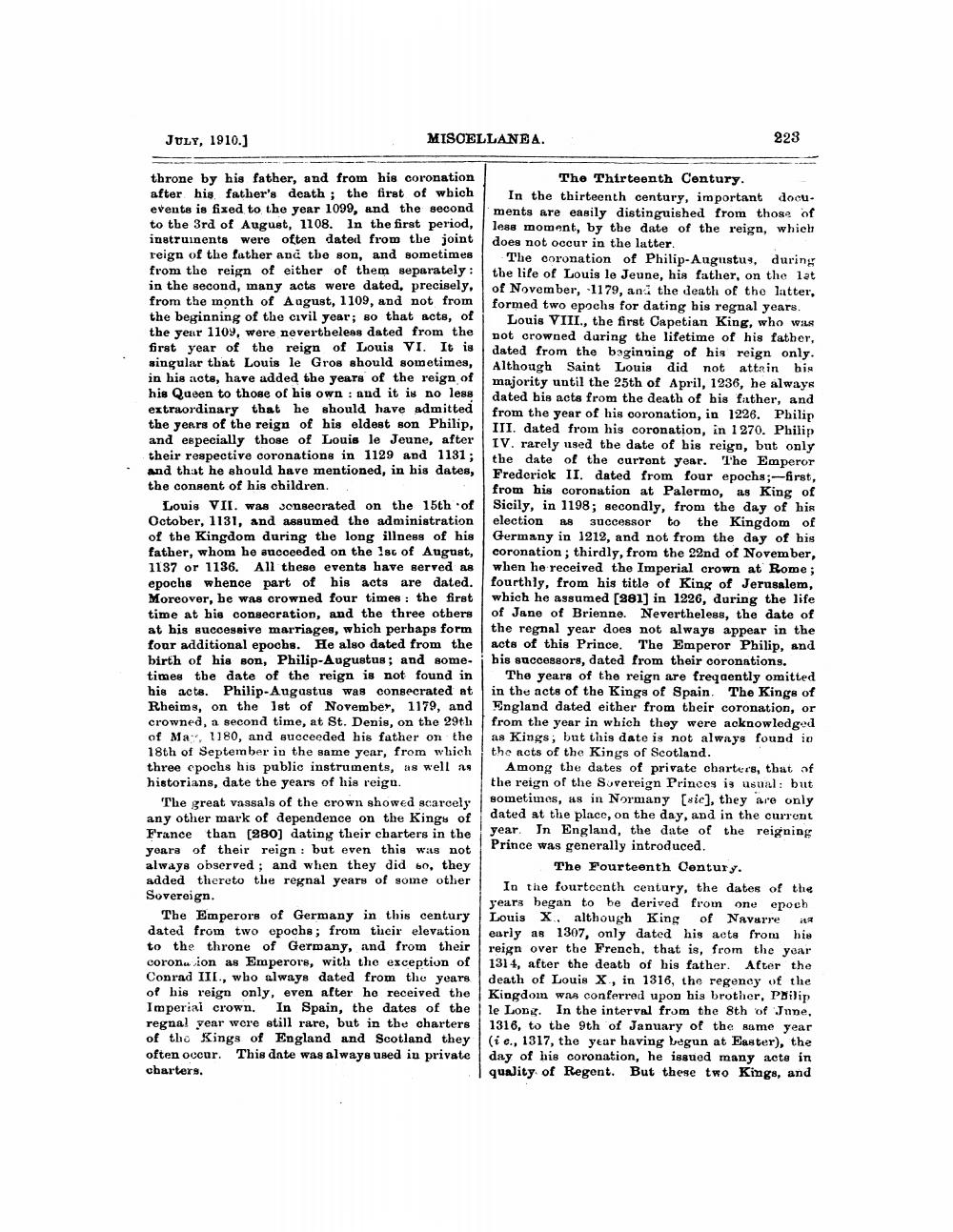________________
JULY, 1910.]
MISCELLANEA.
223
throne by his father, and from his coronation
The Thirteenth Century. after his father's death; the first of which
In the thirteenth century, important docuevents is fixed to the year 1099, and the second
ments are easily distinguished from those of to the 3rd of August, 1108. In the first period, less moment, by the date of the reign, which instruinents were often dated from the joint
does not occur in the latter. reign of the father and tbe son, and sometimes The coronation of Philip-Augustus, during from the reign of either of them separately: the life of Louis le Jeune, his father, on the lat in the second, many acts were dated, precisely. of November, 1179, anx the death of the latter, from the month of August, 1109, and not from
formed two epochs for dating his regnal years. the beginning of the civil year; so that acts, of
Louis VIII., the first Capetian King, who was the year 1109, were nevertheless dated from the
not crowned during the lifetime of his father, first year of the reign of Louis VI. It is dated from the beginning of his reign only. singular that Louis le Gros should sometimes,
Although Saint Louis did not attain his in his acts, have added the years of the reign of
majority until the 25th of April, 1236, he always his Queen to those of his own : and it is no less dated his acts from the death of his father, and extraordinary that he should have admitted
from the year of his coronation, in 1226. Philip the years of the reign of his eldest son Philip,
III. dated from his coronation, in 1270. Philip and especially those of Louis le Jeune, after IV. rarely used the date of his reign, but only their respective coronations in 1129 and 1131;
the date of the current year. The Emperor and that he should have mentioned, in his dates,
Frederick II. dated from four epochs;-first, the consent of his children.
from his coronation at Palermo, as King of Louis VII. was sonsecrated on the 15th of Sicily, in 1198; secondly, from the day of his October, 1131, and assumed the administration election 2.8 successor to the Kingdom of of the Kingdom during the long illness of his Germany in 1212, and not from the day of his father, whom he succeeded on the 1st of August, coronation; thirdly, from the 22nd of November, 1137 or 1136. All these events have served as when he received the Imperial crown at Rome; epochs whence part of his acts are dated. fourthly, from his title of King of Jerusalem, Moreover, be was crowned four times: the first which he assumed [281] in 1226, during the life time at his consecration, and the three otbers of Jane of Brienne. Nevertheless, the date of at his successive marriages, which perhaps form the regnal year does not always appear in the four additional epochs. He also dated from the acts of this Prince. The Emperor Philip, and birth of his son, Philip-Augustus; and some. | his successors, dated from their coronations. times the date of the reign is not found in The years of the reign are freqaently omitted his acte. Philip-Augustus was consecrated at in the acts of the Kings of Spain. The Kings of Rheims, on the 1st of November, 1179, and England dated either from their coronation, or crowned, a second time, at St. Denis, on the 29th from the year in which they were acknowledged of May, 1180, and succeeded his father on the as Kings, but this date is not always found in 18th of September in the same year, from which the acts of the Kings of Scotland. three epochs his public instruments, as well as Among the dates of private charters, that of historians, date the years of his reigu.
the reign of the Sovereign Princes is usual: but The great vassals of the crown showed scarcely
sometimes, as in Normany [sic], they are only any other mark of dependence on the Kings of
dated at the place, on the day, and in the current France than (280) dating their charters in the year. In England, the date of the reigning yonra of their reign : but even this was not
Prince was generally introduced. always observed ; and when they did so, they
The Fourteenth Century. added thereto the regnal years of some other
! In the fourteenth century, the dates of the Sovereign.
years began to be derived from one epoch The Emperors of Germany in this century Louis X. although King of Navarre dated from two epochs; from tincir elevation early 18 1307, only dated his acte from bio to the throne of Germany, and from their reign over the French, that is, from the year coronu ion as Emperors, with the exception of 1314, after the death of his father. After the Conrad III, who always dated from the years death of Louis X, in 1316, the regeney of the of his reign only, even after he received the Kingdom was conferred upon his brother, Pilip Imperial crown. In Spain, the dates of the le Long. In the interval from the 8th of June, regnal year were still rare, but in the charters 1316, to the 9th of January of the same year of the Kings of England and Scotland they (ie., 1317, the year having begun at Easter), the often occur. This date was always used in private day of his coronation, he issued many acte in charters.
| quality of Regent. But these two Kings, and




